 By Pepper Parr By Pepper Parr
April 20, 2020
BURLINGTON, ON
The City has put out an update on what it expects of its citizens.
The parks are closed and are going to remain closed.
City staff are focused on delivering essential services.
With the arrival of warmer weather, residents will start to see City of Burlington staff begin spring maintenance work in City parks and roads:
 Expect to see equipment like this on the streets • Street sweeping has begun on arterial roads and crosswalks with residential roads scheduled to begin mid-May
• Park and roadside litter clean up where needed prior to grass cutting
• Grass cutting will begin but will not include the usual trimming around trees and other objects
• Repair work for grass that has been damaged by sidewalk snow plows will begin the week of April 27with a contractor visiting the sites to fill areas with soil and grass seed
 City wants to keep pedestrian traffic to a minimum. Staff are only doing essential work to maintain City parks, facilities and assets until further notice. Wood chips at the Operations Centre on Harvester Road are not available for pick up during the pandemic and community gardens will remain closed as they have been deemed non-essential by the Provincial government. The City has delayed Community Garden openings until further notice.
To help keep everyone safe during the provincial emergency order, Spencer Smith Park is only available for walk-in traffic. The parking lots are closed and only walking is permitted in Spencer Smith Park, including the Promenade and the Brant Street Pier.
Visitors must keep a two-metre distance from other walkers. No other activities are permitted until further notice: no running, no rollerblading and no biking through Spencer Smith Park. This is to reduce the volume of people in Spencer Smith Park and to help walkers maintain physical distancing.
Physical distancing during the COVID-19 pandemic is one of the most important steps everyone needs to take. The COVID-19 virus doesn’t move on its own; it needs people to move it.
Remember to:
• Keep two metres away from others – about the length of a hockey stick
• Move to the right on pathways to make room for others to pass safely
• Carry out your garbage whenever possible
Respect the caution tape and keep off playgrounds, sports fields, skateboard areas, tennis and basketball courts. The City has signage and barricades in the entrances of parking lots to block vehicles from parking. Vehicles left in parking lots will be towed at the owner’s expense.
Residents who see groups of five or more people gathering or individuals using outdoor recreational facilities can call the Halton Regional Police Service COVID hotline to file a report at 905-825-4722.
Local enforceable orders include:
• Closure of places of non-essential businesses
• Prohibiting events and gatherings of more than five people
• Closure of public places and establishments
• Closure of all outdoor recreational amenities and parks
Burlington Transit
As an essential service, Burlington Transit continues to operate on a modified schedule for essential trips only. Essential trips include going to medical appointments and picking up medication or groceries. Extra buses will be added if needed to help protect drivers and allow passengers to practice physical distancing from other riders. Please use the back doors to enter and exit the bus, keep behind the marked area and follow the recommendations of public health professionals. For more information on Burlington Transit, visit www.burlingtontransit.ca
 Not much work for the parking control people. Parking
Parking enforcement is currently limited to safety-related issues such as fire routes, accessible parking, no parking/stopping areas and blocked areas, including parking lots at Spencer Smith Park, Lowville Park and all other City parks. Time limit restrictions have been relaxed to help those working from home or self-isolating. Parking permits and exemptions are not required until further notice. For more information on parking, visit www.burlington.ca/parking.
Service Burlington
Customer Service staff are available by phone and email for residents’ questions. Online forms can also be submitted via our website. Only in-person services, such as marriage licences, are not available during the pandemic.
 Not going to tie that know this month – maybe not in June either. The City of Burlington is not issuing marriage licences while City Hall is closed. Residents needing a marriage licence can call Service Burlington two weeks before their intended marriage date and if City Hall has re-opened, will be accommodated as close to their wedding date as possible.
Municipalities issue marriage licenses on behalf of the Province of Ontario. Current legislation requires original signatures and documentation. City staff have asked the Province to review this legislation and make some interim amendments to allow for electronic signatures and documentation. Staff is also asking the Province to extend the licenses that were issued prior to the COVID-19 shutdown beyond the normal 90-day expiry dates.
In-Home Activities
The best thing residents can do to protect themselves and the community, is stay home. The City of Burlington and its partners have put together a list of activities people of any age can do while staying home at burlington.ca/programming. The list includes:
• Virtual fitness
• Free music
• Ebooks, emagazines and online resources from Burlington Public Library at bpl.on.ca
• Videos for recreation programming such as games, activities and crafts.
 Mayor Marianne Meed Ward cautions people. “As the weather gets warmer we know it will be harder to follow the provincial emergency orders, and the directives from Burlington City Hall. But we must continue to stay apart, and stay in our own neighbourhoods, so we can get through this sooner. Please resist the urge to congregate in groups, stay 6 ft. away from anyone you don’t live with and please stay in your own neighbourhood and local parks for your walks. Mayor Marianne Meed Ward cautions people. “As the weather gets warmer we know it will be harder to follow the provincial emergency orders, and the directives from Burlington City Hall. But we must continue to stay apart, and stay in our own neighbourhoods, so we can get through this sooner. Please resist the urge to congregate in groups, stay 6 ft. away from anyone you don’t live with and please stay in your own neighbourhood and local parks for your walks.
“Walk, don’t stop, and stay off playgrounds, benches and other park amenities. In particular, please do not come downtown to the waterfront where there has been some crowding in Spencer Smith Park and Beachway Park. We have taken extra measures to restrict the use of these areas.
“We know how difficult this has been so far for our residents, but it will only get more difficult the longer we have to keep these directives in effect. The longer we stay apart now, the sooner we can safely come together.”

 By Pepper Parr By Pepper Parr
April 19th, 2020
BURLINGTON, ON
City Manager Tim Commisso’s life has been boiled down to a single word – Risk!
 City manager Tim Commisso Everything he looks at is seen through a single lens; it is as if he is wearing a monocle.
Every decision is – what is the risk of doing something or the risk of not doing something.
His one job is to ensure the city provides the services needed to keep people safe and that staff provide the services needed to keep the city operating. It is a challenge.
Few have much in the way of an idea as to just how complex this is.
Commisso runs the show. His word is the final word. He listens and takes advice but at some point he has to make a decision and be held responsible.
He doesn’t always get it right. He had to learn to open up and ensure that members of Council were kept in the loop – aware of what was being done and why.
He is now giving Councillors a report each week.
He has the best people on the city payroll available to him at that virtual table – they communicate as a group twice a day – all by telephone.
The Mayor is reported to be the backup and takes turns chairing the Emergency Coordinating Group (ECG)
The two charts below show the ECG organizational chart that was created March 17th. The detail quality is poor – we have asked the city for a graphic with a higher resolution.
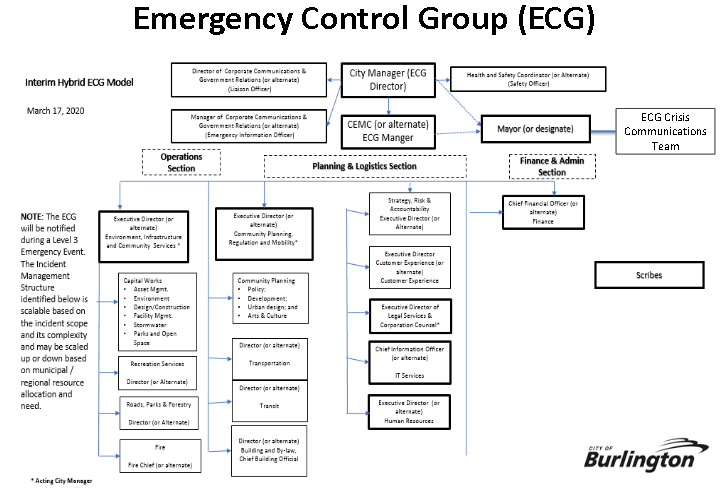
Commisso has set out the timeline he plans to follow in reporting to Council.
CSSRA is the acronym for the Corporate Services, Strategy, Risk and Accountability Standing Committee that is chaired by Rory Nisan with Paul Sharman as the vice chair.


 By Staff By Staff
April 20th, 2020
BURLINGTON, ON
This is not what we wanted to hear at the start of a new week.
“Humanity will have to live with the threat of coronavirus “for the foreseeable future” and adapt accordingly because there is no guarantee that a vaccine can be successfully developed, one of the world’s leading experts on the disease has warned.”
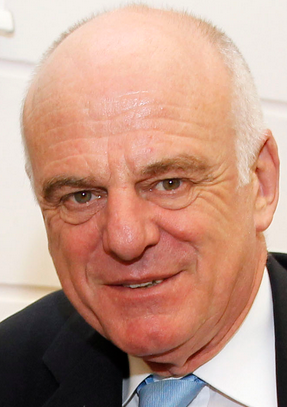 David Nabarro In an interview with The Observer, David Nabarro, professor of global health at Imperial College, London, and an envoy for the World Health Organization, said the public should not assume that a vaccine would definitely be developed soon – and would have to adapt to the ongoing threat.
“You don’t necessarily develop a vaccine that is safe and effective against every virus. Some viruses are very, very difficult when it comes to vaccine development – so for the foreseeable future, we are going to have to find ways to go about our lives with this virus as a constant threat.
 Imperial College, London “That means isolating those who show signs of the disease and also their contacts. Older people will have to be protected. In addition hospital capacity for dealing with cases will have to be ensured. That is going to be the new normal for us all.”
When it comes to credibility the Observer, a British newspaper, is as good as it gets and the Imperial College, London has a sterling reputation in these matters

 By Staff By Staff
April 18th, 2020
BURLINGTON, ON
On a Saturday afternoon when the news world is usually quiet the Region of Halton advised that the Mountainview Retirement Residence had:
63 residents and 18 staff confirmed as COVID-19 cases, with some lab results still pending.
8 deaths
The Public Health unit became aware of problems at Mountainview on March 31st – 16 days ago.
 The Mountainview Retirement residence in Georgetown – 8 Covid19 related deaths.  Data made public on the 15th did not indicate what was behind the Halton Hills number. 
 By Pepper Parr By Pepper Parr
April 18th, 2020
BURLINGTON, ON
The height of a building, the architecture and design are both important and for the people of Burlington they are, at this point, a major focus.
 But more important than the two is the street. But more important than the two is the street.
Streets are where we live – yes, your home is on a street but a lousy street ruins the most impressive home.
Ward 4 Councillor Shawna Stolte will be putting a motion before Council on Monday – she wants to change the way streets are used during this COVID-19.
Stolte wants to direct the Director of Transportation Services to assess, create and implement as soon as possible, and with input from other city departments and members of the Cycling and ITAC Committees, a “Shared Streets Burlington” Pilot Project with the goal of temporarily closing portions of roadways to allow for safer physical distancing for pedestrians and cyclists for the duration of the COVID-19 pandemic.
 Under normal conditions – this is more then enough sidewalk – but these are not normal times The residents of Burlington, along with City Council and City Staff, are all committed to the goal of stopping the spread of COVID-19 in our community.
Stolte accepts that the role of City Council and staff, is to amplify the message of medical experts in regard to adhering to physical distancing requirements while also considering a longer term plan that acknowledges residents need for physical exercise and fresh air in order to effectively manage their mental health and well-being.
She points to recent Angus Reid Poll that asked, “if there is anything residents are doing more of than normal since being isolated” and 53% reported “going for more walks” and 26% reported “taking up extra exercise”.
City streets and sidewalks are places residents are permitted to travel outside their homes but sidewalks are simply not wide enough to ensure the physical distancing requirements recommended by medical experts and the informal use of grass boulevards does not provide a safe nor viable alternative for wheelchairs, strollers or bicycles.
 Is shutting down a street and opening it up to people who can just walk and ride bikes a solution? These sidewalks and multi-use paths are becoming more congested as the seasons change, temperatures are rising, and residents seek outlets to support their mental health and well-being.
The space to expand outdoor physical distancing is available.
Roadways are underutilized due to reduced traffic volumes and represent a clear and simple alternative to “expand the sidewalk”.
There are many resources already available, as well as an established work group comprised of dedicated residents from the ITAC and Cycling Committee who have been meeting to research strategies and suggestions for implementation.
Some suggestions are as follows:
- begin with a Pilot Project to measure, monitor and learn as well as to assess the willingness of the community to participate in a safe manner;
- consider a phased approach that can adapt/expand as needed;
 Community walks like this are not on – the Beachway Trail can’t handle the traffic – can part of the roadway be opened to pedestrians?
- offer multiple, local, widespread, “very ordinary” locations to create the opposite of a destination to avoid gathering crowds
- to network streets and coordinate with park locations;
- ensure strong signage and communication;
- consider a variety of options such as closing off curb lanes on thoroughfares (ex. Maple, Palladium Way, Prospect -east of Guelph) or installing strong “Shared Streets” signage on key neighbourhood streets (ex. Spruce, Townsend, Palmer, Millcroft Park)
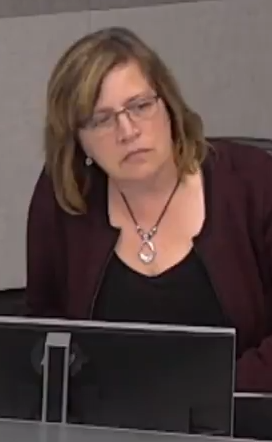 Ward 4 Councillor Shawna Stolte has put a good idea on the table – now the community has to join in and flesh this out. The bureaucrats need to lighten up a little and get creative as well. Stolte points out that the “motion is intended to encourage a realistic, longer term plan that will ensure safe “physical distancing” as well as strive for the balance that is needed to support physical exercise and mental health initiatives, by literally creating more space for people to get outside and breathe.
It’s an interesting idea – Stolte has done her part. Now it is up to the people who live on those streets to think about how they would change their streets.
Talk to your neighbours – write up your ideas and send them to the Councillor – at ward4@burlington.ca
Let’s see if this idea has any traction.
And let’s see how creative the folks in the Transportation Department can be.

 By Pepper Parr By Pepper Parr
April 17th, 2020
BURLINGTON, ON
City Council will learn from city staff what they expect the financial impacts of COVID-19 will be and seek Council’s endorsement of a three-month strategy that prioritizes which City services will be provided through to the end of June 2020.
Out of those deliberations will come a three-month work plan for the strategic management of the City budget and finances.
A statement from the administration seeks to assure City Council that staff remain committed to fiscal responsibility and accountability and are focused on offsetting all of the COVID-19 related City revenue losses to June 30, 2020 and are looking ahead past July 2020 to mitigate a shortfall at 2020 year-end.
A report detailing the impacts of the COVID-19 pandemic on the City’s budget will be presented. This report will include:
• estimated revenue impacts of $7.6 million to June 30, 2020
• estimated expenditure savings of $5.2 million to June 30, 2020
• cash flow projections to June 30, 2020
• future financial modelling to identify pressures, dependent on the length of the pandemic, and recovery scenarios.
Municipalities are required to approve a budget that is balanced, however, the City can have a shortfall or surplus in a given year. A shortfall can be offset by:
• using reserve funds
• increasing taxes in the next year; or
• reducing expenditures during the year of the anticipated shortfall.
Burlington is attempting to mitigate a shortfall at year-end.
 Mayor Marianne Meed Ward Mayor Marianne Meed Ward said: “Our City is currently in a good position thanks to savings we’ve acquired through our winter maintenance budget, the result of a light winter, and major tenders that came in under budget.
 Joan Ford, Chief Financial Officer Joan Ford, Chief Financial Officer is the one who has to do the numbers juggling. Ms Ford and her team have always been conservative and cautious. She explains that: “In recognition of significant revenue losses such as transit fares, recreation programming and property tax deferrals, an expenditure restraint program was immediately implemented across the City to assist in mitigating the financial impacts.”
Will council listen or will they scour the reserve funds and look for ways to make up the shortfall from that source?
Monday is going to be a long day for city council – how deep their hands go into your pockets in the years ahead will be determined then.

 By Pepper Parr By Pepper Parr
April 17th, 2020
BURLINGTON, ON
The April 20 City Council meeting will begin at 9:30 a.m. instead of 6:30 p.m.
The media release said the early start was to provide residents with the opportunity to watch a live stream of the meeting at a more convenient time.
The agenda is very heavy – they couldn’t possibly get through it all during an evening session.
The public can view virtual Council meetings remotely using the City’s existing web streaming tool at www.burlington.ca/calendar.
 It will be the Mayor, the Clerk and the audio/visual technician only in the Council Chamber – the rest will be at home wearing headsets and participating virtually. While no delegations are currently permitted, written comments may be submitted to the City Clerk by email at clerks@burlington.ca.
Received written submissions will form part of the public record and will be distributed to members of Burlington City Council.
Will they be read?
Live delegation presentations give Councillors an opportunity to ask questions and to follow up – that vital part of the delegater being in the room is lost.
Council will consider a recommendation to allow virtual delegations from members of the public at Council meetings, beginning in May 2020.

 By Ray Rivers By Ray Rivers
April 17th, 2020
BURLINGTON, ON
It’s a mess.
Long term care homes are host to about half of all of Canada’s COVID-19 fatalities. Ontario has 626 nursing homes, a little over half are privately operated, a quarter non-profit, and the rest municipal. There are close to 80,000 beds in use and there is a waiting list almost half as long again.
The costs of long term care are co-funded between the province and the patient. In 2018 provincial funding totalled $4.28 billion, less that a tenth of the provincial health budget, which amounts to about $150 per resident a day. That is board, room, cleaning and care for a little over $50,000 per patient per year plus the patient’s co-fund.
There was this idea once that for that kind of money, one could book a year-long ocean cruise, and get everything except the medical care. But nobody ever thought that they might also get stuck, like the 4000 Canadians on some 70 cruise ships, as of late March this year, who can’t get off because of COVID 19.
 Quebec has called on the federal government to bring in the army’s medical corps to help with their lack of health care at long term facilities But Ontario is putting an ‘iron ring’ around its institutions according to its premier, who has promised to leave no stone unturned, spare no expense.… Quebec has called on the federal government to bring in the army’s medical corps to help with their lack of health care at long term facilities But Ontario is putting an ‘iron ring’ around its institutions according to its premier, who has promised to leave no stone unturned, spare no expense.…
Next week he finally will ban support staff from working in more than one long term facility, thereby eliminating a potential source of spread. But B.C. had brought in a similar regulation almost a month ago and Ontario had enacted a similar rule back during the SARS crisis. So why has it taken this long for Ford to act? Perhaps he empathized with the long term support staff, having to take on extra employment to make up for their miserable pay levels.
It’s not Ford’s fault that COVID 19 came to Canada and Ontario. The virus arrived here with travellers arriving first from China, then from other places. As the contagion got a foothold and spread, we remained calm on the advice of Canada’s chief medical officer.
 Dr. Teresa Tam: Chief Medical Officer of Health Dr. Tam told us that the risk to Canadians was minimal and there was no need for travel restrictions, quarantine or protective masks to reduce the risk of exposure. So today Ontario has had over 500 deaths and over half of those are in long term care.
But Ford’s record in this is anything but spotty clean. Jurisdictions, like South Korea, which have minimized the coronavirus casualties, have used extensive testing to identify, isolate and treat the infected. Ontario has the lowest record of testing in Canada, and that may explain why its infection numbers appear lower than they actually are – and why our death rate is so high.
Following the SARS crisis masks and other personal protection equipment (PPE) were stockpiled, but they got stale dated and eventually junked. But nobody, even in the previous administration, thought to rebuild the stockpile. So now Ford and his health minister are promising to fix this, even if late and too little.
Ford changed the labour laws in the province reducing sick leave days for employees and allowing employers to demand a medical certificate. In the early days of the epidemic this may have contributed to the virus spread, since sick employees would need to still go to their jobs to get paid, and those who didn’t needed to visit their doctor’s crowded offices for their medical certificate.
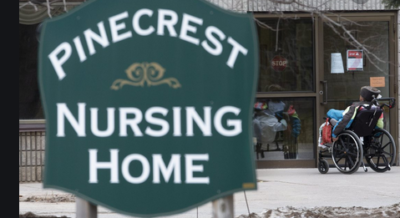 A nursing home in Bobcaygen where 29 patients in a 65 bed facility died of COVID19 But perhaps worst of all, when it comes to long term care the Ford government had stopped inspecting health and safety conditions in nursing homes as a matter of policy. These annual inspections are the only way the province had to ensure that a nursing establishment was meeting it’s health, safety and licensing requirements.
Inspections went from 100% in 2017, under the previous Liberal government, to almost zero last year. Is it any wonder infection has spread so rapidly?
Instead of an annual snap Inspection for all homes conducted during the previous government only 9 of 626 were inspected in 2019.
Unfortunately this brings back memories of another Conservative premier who rolled the dice, deregulating water safety. That ended up with 7 people dying and half of a town’s people sickened. That policy, like Ford’s decision on inspections, was ideological, about cost cutting, eliminating red tape and promoting deregulation.
Australia has a different take on long term care. Their system is national and publicly run under strict rules and inspections. Australians saw where this virus might be heading before anyone called it a pandemic and responded much faster and more effectively than Canada, even though their first case arrived two days after ours.
And their long term deaths have been low, making them a model for us to emulate in this country. In fact there have been twice as many COVID 19 deaths in Ontario’s long term care homes than among Australia’s entire population of 25 million. Clearly they are doing something right.
 The government of the day – Mike \Harries Tory’s failed the people of Walkerton. Doug Ford has told us that his wife’s mother is a patient at a Toronto nursing home. One has to wonder what she thinks. After all, his is the kind of subtle negligence which eventually came back to haunt former PC premier Mike Harris. We’ll see eventually if this is really an iron ring or just Mr. Ford’s Walkerton.
Nobody wants to criticize a political leader during a time of an unprecedented health crisis. Doug Ford rose up in everyone’s expectations with his early daily briefings, closing the schools, declaring a state of emergency and gradually locking down the province’s economy. It was comforting to see someone in charge.
He could have moved faster and shut down more non-essential workplaces earlier, like construction. And public transit across the province should have been shut down as it has been in other places where social distancing is impossible. Ford’s people should have embraced masks earlier, instead of simply regurgitating the mis-truths from the World Health Organization and Canada’s own Dr. Tam.
And he could have left the provincial parks open. After a month of lockdown people need to get out for some exercise and fresh air. It would be easier to social distance on a park trail or open field than a crowded sidewalk, wouldn’t it?
Lately Ford has pretty much run out of ‘breaking news’ for his daily press conferences. They’ve started to morph into poorly staged political rallies, as the Premier and his beleaguer health minister tell us how they are there for us and doing all they can. And watching the two of them in action confirms for me that the PC’s did the right thing in nominating Ford for the top job.
 Ontario Premier Doug Ford Ford recently got angry complaining about Ontario’s pathetic rate of COVID 19 testing. But then seriously, isn’t he the premier? We want Ford to succeed in fighting this epidemic. It’s in all of our interests regardless of any political stripe.
But we need to have faith and believe in our premier. And that means some straight talk instead of hype and empty promises. Ford could begin by recognizing what has gone wrong and assuring us that he has learned from his mistakes.

Ray Rivers writes weekly on both federal and provincial politics, applying his more than 25 years as a federal bureaucrat to his thinking. Rivers was a candidate for provincial office in Burlington where he ran against Cam Jackson in 1995, the year Mike Harris and the Common Sense Revolution swept the province.
Background links:
Long Term Care in Ontario – Ford Didn’t Protect Them – COVID 19 Spread in Ontario Nursing Homes –
Masks Destroyed – Long Term in Australia –

 By Staff By Staff
April 17th, 2020
BURLINGTON, ON
The Regional Public Health Unit releases updates on COVID-19 crisis up to and including Wednesday end of day on April 15, 2020:
Cases over time
34 COVID-19 cases reported to Halton Region Public Health since the last update (24 confirmed + 10 probable)
393 COVID-19 cases reported to Halton Region Public Health to date (350 confirmed + 43 probable)
 COVID-19 cases, by reported date, Halton Region, Mar. 1-Apr. 15, 2020
Figure shows the 393 COVID-19 cases that had been reported to Halton Region Public Health by end of the day on April 15. All cases have been graphed according to the date they were reported, which is often several days after the onset of symptoms. Among the cases in this figure, 34 were reported since the last update (meaning they were reported between April 13 and April 15, 2020).
Individuals who are lab-confirmed cases are shown in green. Individuals who are probable cases are shown in orange. Probable cases are epi-linked cases, which means they are presumed to have COVID-19 because they are symptomatic close contacts of cases or returning travelers who have COVID-19 symptoms.
Case demographics
67 cases live in an institution (17% of all cases)
55 cases work in health care (14% of all cases)
 COVID-19 cases, by age and sex, Halton Region, 2020 Figure shows that by end of the day on April 15, the most COVID-19 cases were among Halton residents aged 40-59 (with 136 cases, or 35%). 232 of the 393 cases (59%) were female.
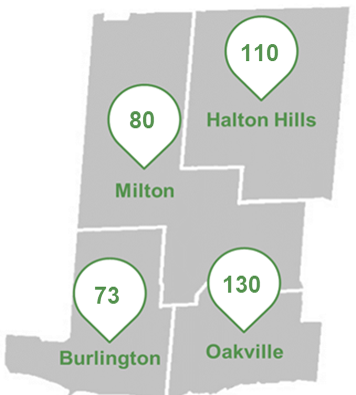 COVID-19 cases, by municipality of residence, Halton Region, 2020 Figure shows that by end of the day on April 15, the greatest number of COVID-19 cases were among residents of Oakville (with 131 cases, or 33%). Please note this figure shows counts, and therefore does not take into account the different population sizes or age structures of the four municipalities. Counts in municipalities can also be inflated by outbreaks that have occurred within institutions in their boundaries.
Case exposure source
 Percentage of COVID-19 cases, by exposure source, Halton Region, 2020 Figure shows that by end of the day on April 15, 175 of Halton Region’s COVID-19 cases (45%) had no known travel or contact history, and therefore were believed to have acquired the virus within Ontario, making them community cases. 118 cases (30%) had contact with a confirmed case that was believed to be the source of their infection. 88 cases (22%) had a history of travel that was believed to have been the source of their infection. Information on exposure source was pending for the remaining 12 cases (3%).
Case outcomes
52 cases who have ever been hospitalized to date (27 listed as currently in hospital)
146 cases who have recovered to date
12 cases who have died to date (7 of the deceased were institutional residents)
Institutional outbreaks
0 confirmed institutional outbreaks of COVID-19 reported to Halton Region Public Health since the last update
7 confirmed institutional outbreaks of COVID-19 reported to Halton Region Public Health to date
Among the seven confirmed institutional outbreaks reported to date, four (57%) have been in retirement homes, while two occurred in long-term care homes and one occurred in a hospital. None of the confirmed outbreaks were reported since the last update. None of the confirmed outbreaks have yet been declared over. Please note these counts do not include any suspected outbreaks that remain under investigation.
Lab testing
6,000 Halton residents are known to have been tested for COVID-19 to date
Comparison to Ontario
8,961 total confirmed COVID-19 cases reported in Ontario to date
 Age-specific rates of COVID-19 (per 10,000 population), Halton Region and Ontario, 2020 Figure 5 shows age-specific rates of COVID-19 for Halton and Ontario. Rates take into account the population size of each age group to make it possible to compare between different areas. Halton’s age-specific rates are similar to the provincial rates for all age groups (for example, while Halton has 27.4 cases per 10,000 residents aged 80+, this is not statistically significantly different from the 24.1 cases per 10,000 residents aged 80+ in Ontario). It is important to note that these rates will fluctuate as numbers increase throughout the pandemic, and that differences between age groups may reflect differences in the likelihood of developing symptoms and being tested.
Data limitations and data sources
Halton case data: integrated Public Health Information System (iPHIS), extracted at 7:00 AM on April 16, 2020, to reflect data entered by the end of the day on April 15, 2020
Halton lab data: COVID Data Information System, extracted on April 16, 2020.
Ontario case data: Public Health Ontario, Epidemiologic Summary, COVID-19 in Ontario: January 15, 2020 to April 15, 2020, posted on April 16, 2020 to https://www.ontario.ca/page/2019-novel-coronavirus
Denominators for Halton and Ontario age-specific rates: Population projections [2020], IntelliHEALTH Ontario, extracted on April 8, 2020.
Data notes
All cases of diseases of public health significance diagnosed in Ontario are entered into iPHIS by local public health units. iPHIS is the Integrated Public Health Information System. It is a dynamic disease reporting system which allows ongoing updates to data previously entered. As a result, data extracted from iPHIS represent a snapshot at the time of extraction and may differ from previous or subsequent reports as data are updated.
The data only represent cases reported to public health and recorded in iPHIS. As a result, all counts will be subject to varying degrees of underreporting due to a variety of factors, such as disease awareness and medical care seeking behaviours, which may depend on severity of illness, clinical practice, changes in laboratory testing, and reporting behaviours.
Cases are included if their “diagnosing health unit” in iPHIS is Halton Region, which means counts include only individuals whose primary residence is in Halton Region. The case may not necessarily have been managed by Halton Region, if they were temporarily residing elsewhere during their case management period. Cases managed by Halton Region who normally live elsewhere but who were managed by Halton Region staff because they were temporarily residing in Halton during their case management period have not been included.
Cases for which the Disposition Status in iPHIS was reported as ENTERED IN ERROR, DOES NOT MEET DEFINITION, DUPLICATE-DO NOT USE, or any variation on these values have been excluded.
Figure 1 distinguishes between lab-confirmed and probable cases. Since April 7, probable cases are defined as epi-linked cases, meaning they are symptomatic close contacts of cases or returning travelers who have COVID-19 symptoms and therefore are presumed to have COVID-19. All other figures and numbers include both confirmed and probable cases combined.
In subsequent reports, counts in Figure 1 may increase as cases are added from past dates due to delayed data entry or new arrival of lab results. To minimize such retrospective changes, cases have been graphed according to case reported date, which does not reflect onset of illness.
Cases are considered to live in an institution if the name of a facility (e.g. a long-term care home, retirement home, prison) has been entered for their address in iPHIS.
Cases are considered to work in health care if they are known to have an occupation that involves caring for patients, e.g. physician, nurse, occupational therapist, recreational therapist, chiropractor, paramedic, midwife, orderly, etc.
Exposure type is determined by examining the exposure and risk factor fields from iPHIS to determine whether a case travelled, was a contact of a case or neither. A hierarchy has been applied as follows: Travel-related > Close contact of a confirmed case > Neither (indicating community acquisition) > Information pending.
Case outcomes (hospitalizations, recovery, deaths) reflect the latest available information reported to Halton Region Public Health and recorded in iPHIS by the extraction time.
Institutional outbreaks include outbreaks of COVID-19 in settings such as long-term care homes, retirement homes, hospitals, and prisons.
Lab testing data reflects only lab tests that have been reported to Halton Region Public Health and entered into CDIS. There may be more residents who have been tested but not reported to Public Health.
Related Regional Health reports
April 9th data
April 12th data

 By Jim Young By Jim Young
April 16, 2020
BURLINGTON, ON
I have lived on Silwell Court, which backs on to the controversial 2100 Brant Street Development, for 28 years. I know the neighbourhood and the people involved, they were my neighbours. I also know John Calvert; a quiet, capable former Mississauga city planner. He and I share notes on planning issues and I am always the wiser for his thoughts.
Like John, I worked for change at the last municipal election, hopeful that those changes would bring greater local resident input on city plans. Also, like John, while happy with much of our new council’s work on Transit, Climate Change and the recent Covid-19 crisis response, I am equally disappointed in their approach to land planning issues. His Op-ed piece on 2100 Brant Street and the Gazette picture juxtaposing the proposed 233 units with the 236 surrounding homes says all that needs to be said about over-intensification, poor planning and design.
 The blue area denotes the Havendale community with 236 homes. The orange area is the proposed National Homes development where 233 homes would be built. But greater than any objection to that development is my fear that the process to approve it indicates how future planning applications will be handled and resolved by the city. A process that not only limits the public input electors demanded in the 2018 council rout, but leaves us wondering whether it is an unfortunate confluence of conflicting provincial / municipal planning ideologies or intentional city planning policy; forsaking local input for expediency.
First it is only fair to point out that, even with the best of intentions, municipal planners are severely limited by The Ontario Planning Act. Developer amendments to zoning bylaws and official plans, are assessed, not necessarily on the local impact or wishes but more on how they comply with provincial planning legislation and guidelines. Also, the time for city planners to assess those amendments is severely limited by the Planning Act. Even the much debated Official Plan, still in the works after so many years, must comply with The Act and subsequent provincial guidelines on density, transit and mobility.
The land use planning, amendment and appeals process was already complex and changes by two successive provincial governments and an ongoing Official Plan review by the city have made the whole process so complex as to be un-navigable by planners and unintelligible to us mere citizens.
The old process was: The city’s Official Plan regulates what may be built. Developers who wanted to deviate from that submitted amendment applications to the city are approved or disapproved. Prior to submitting the application, developers held a statutory public meeting to inform residents of the proposed changes. Cities had 120 days to respond to applications. Developers could appeal unfavourable planning decisions to the OMB (Ontario Municipal Board). Failure by the city to respond in time was also grounds for an appeal by the developer.
The first change, in early 2018, saw the OMB replaced by LPAT (Local Planning Appeals Tribunal), a supposedly more municipal and resident friendly body. It allowed 180 to 210 days for cities to respond to amendment applications and made it, theoretically, easier for local residents to contest developer proposals. Before any of this could be tested, the Provincial election that year changed the government.
 Burlington MPP Jane McKenna at the ground breaking of The Gallery, the 23 storey tower going up opposite city hall. The provincial government delivered regulatory changes that kept developers smiling. With that change, a more development friendly government cut amendment application response times to 90 or 110 days and changed much of the amending criteria in favour of development. In a city which still had no official plan in place and a large number of pending applications, this was an impossibly tight deadline to meet. Throwing further confusion into this was the Review of the Official Plan, demanded by the electorate and concentrating on the downtown.
In a bid to allow planners time to develop the new official plan free from ongoing amendment applications the city froze the planning process using an Interim Control Bylaw. (ICBL)
We can argue whether this was undertaken properly, if the (ICBL) was successful? If the Downtown Transit Hub should have been addressed first? If the revised downtown plan is any better? But those are arguments for another column.
The outcome has been that on top of all the in-process amendments, frozen by the ICBL, developers lodged a further thirty one appeals to LPAT opposing the new plan and the ICBL. Add to this a city and a province beset by a Covid 19 lockdown and the whole process has simply seized up. Applications are frozen again, LPAT appeals are suspended and there seems to be confusion about whether the application deadline clock is still ticking or not. An email from Heather MacDonald, Executive Director, Community Planning Regulation and Mobility suggests to me the clock is frozen too, an article in the Gazette, April 14 suggests the issue is being debated at the province but there is no decision as yet.
The debate now becomes: Is the city a victim of powerful and shifting provincial planning whims? Or is the city happy to hide behind a land planning regime it cannot win against and capitulates to quietly while still disingenuously proclaiming its defence of resident interests?
I am beginning to believe the latter. Reading John Calvert’s plea to our mayor, one might reasonably conclude that the city’s new approach to planning amendments is: Receive the application. Sit on it until the response time runs out. Let the developer appeal to LPAT, then negotiate a settlement agreement with the developer with almost no input from local residents.
I worry that, with the city’s planning in an unresolvable mess and aware that municipalities are virtually powerless anyway, our elected council has found a way to live with a pro developer provincial planning regime while shrugging off responsibility for the outcomes.
I further worry that in a “Covid Shutdown” political environment, what little resident or municipal input exists in the planning process will be further eroded by meetings in camera, with no traditional citizen delegation.
Related news articles:
Calvert letter to the Mayor on trust
The pain Calvert carries
Marianne Meed Ward on trust.
 Jim Young is an Aldershot resident who delegates at city council on transit and local development. He is consistent in his mission to ensure local government is transparent and accountable to the people who elected them. Jim Young is an Aldershot resident who delegates at city council on transit and local development. He is consistent in his mission to ensure local government is transparent and accountable to the people who elected them.

 By Pepper Parr By Pepper Parr
April 16th, 2020
BURLINGTON, ON
The City Council meeting on Monday will be a much different presentation.
First – it will be delivered via Zoom which should take out a lot of the glitches that were encountered during the two previous virtual city council meetings.
The Clerk’s office still does not appear to have come up with a way to permit delegations – and given the agenda we have been led to believe they will be working from – it is going to be a whopper of an event.
Each of the departments is reported to have prepared a report on what they have been up against and what the closure of many programs is going to do to their budgets.
The reports are said to be lengthy.
The decision to use Zoom apparently didn’t come from the city’s techy people – a Councillor who had experience with Zoom during her time on the Library Board managed to convince the city manager that it was worth a try.
There is nothing all that elegant about Zoom – but it is functional. Councillor Galbraith reports that they have been given headsets which should make it easier to communicate to each other.
The most important part of the COVID-19 crisis is sound communication with a central point where the decisions are made.
Burlington is basically run today by the Emergency Control Group that is made up of every level of bureaucracy, the police, fire, ambulance – and the people who deliver the essential services.
They meet at least twice a day every day and manage the issues that crop up.
The bylaw they work under has the Mayor representing the voice of city council. The Mayor seems to have interpreted that to mean she is THE voice of council and much of her behaviour leaves the impression that she is not only leading the parade – but IS the parade.
There is thought to be some turmoil between the 7th and 8th floors of city hall. The Councillors are all on the 7th floor with the Mayor and her team on the 8th.
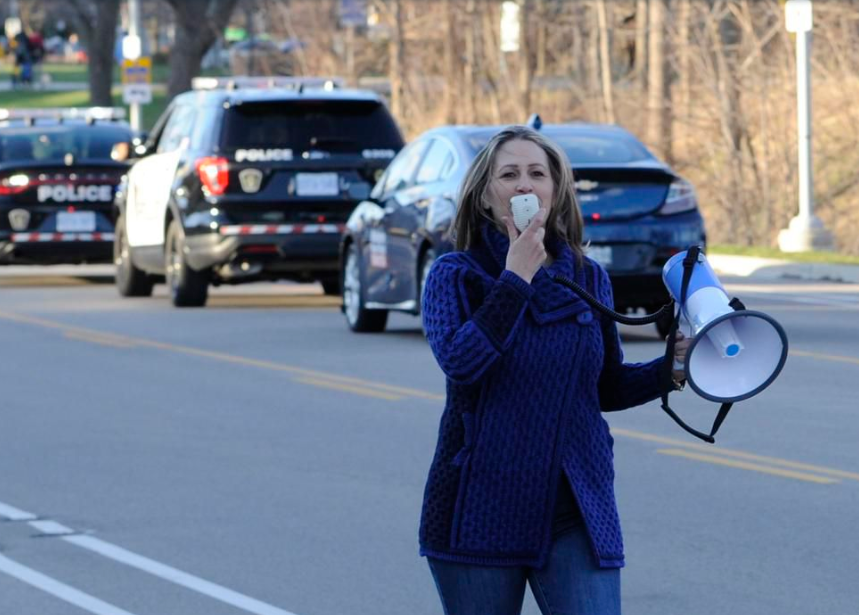 Mayor Marianne Meed Ward in front of the hospital convey the public’s gratitude for the service they are giving and the risks they are taking. The Mayor has taken to holding Front Line Claps to support the people who are not ill but put themselves at considerable risk taking care of those who need care.
Last Friday, instead of clapping from the veranda of her house the Mayor took to her car and was part of a caravan of vehicles that drove down Maple and onto the hospital grounds where she lead at least 15 first responder vehicles.
They pulled up in front of the hospital where the Mayor hopped out with a megaphone in her hand and addressed whoever in the hospital could hear her. The Mayor was alone – no members of council with her. It would have been a very simple matter to invite the other members of council to take part.
Didn’t happen.

 By Pepper Parr By Pepper Parr
April 16th, 2020
BURLINGTON, ON
It’s a bit of a numbers game – with each level of government using their own data.
The public would love to see a single point where all the data resides. Not likely to see that any day soon.
The Region provides the local data. This afternoon they released the following:

It is pretty clear now that the danger point is the long term care centres and the nursing homes – where in Halton Region 17% of the cases are from those locales.
Based on what we are getting from the Regional Public Health people – there have not been any deaths in the homes.
Hopefully that is due to the quality of the care being given and the very strict adherence to the rules and not luck. The Long term care facilities are run by the Region where staff would be full time.
The data indicates that the really high at risk demographic is not taking the hit that other parts of the province are experiencing.

 By Staff By Staff
April 16th,2020
BURLINGTON, ON
Burlington Recreational Services team is piloting TelePALS – Telephone Partners in Accessing Leisure Services.
 Connecting those that are isolated 15 people at a time. It is a service that allows people who may not know each other to connect and communicate by telephone. The Seniors’ Centre Without Walls (SCWW) is as simple as just picking up your telephone!
Through the use of multi-person phone calls, SCWW provides the opportunity for participants to join in on health and wellness seminars, educational lectures, brain-stimulating activities, listen to live musical entertainment, join in on general conversations, and make new and meaningful friendships – all from the comfort of home! It works just the same as attending a class or a lecture at the centre, but instead it is facilitated over the telephone.
Seniors’ Centre Without Walls Basics:
Completely free program.
You do not need to be a member of any association.
Programs are multi-person phone conversations (or conference calls).
No special equipment needed – just your average phone!
Call yourself in to the program, or we can call you – it’s your choice!
Each phone session lasts between 30-60 minutes on the phone.
Each phone session averages 10-15 people on the call.
You are able to hear each other, talk to one another, learn, and/or just have fun!
The first phase of the pilot involves people referred to Parks and Recreation; phase two will have broader participation.
Since the closure of City programs the team doing the pilot has conducted a Caring Calls program reaching over 2500 participants. They heard that many of our community valued these calls very much and the point of connection they provided.
“Many also indicated a desire to be contacted again. Because we became aware of so many people experiencing a sense of isolation, we thought we would start TelePALS with these folks first, and then increase the service by promoting it more broadly to the City in coming weeks.
“At this time if you know of friends, families, clients or other individuals that are not on-line, or not comfortable with computers but would like to hear more about Telephone Recreation programs via TelePALS, could you contact Mandy Newnham (mandy.newnham@burlington.ca) for more information.”
The first priority would be to reach older adults or individuals who may be more home-bound due to a disability; they expect to expand very quickly to enroll any older adults interested in the programs.
The city has yet to go public with this program – we stumbled across what they were working on. We will do our best to keep you posted – the Parks and Recreation are not known for their ability to communicate all that well.

 By Staff By Staff
April 16th, 2020
BURLINGTON, ON
The men and women who enter the Joseph Brant hospital every day deserve every scrap of support that can be found.
People bang pots and pan and clap for two minutes on Friday evenings – some people are providing meals and other levels of support for those workers who are doing 12 hour shifts.
Unfortunately, earlier this week the hospital announced that 12 staff members and three patients were identified as having contracted the COVID19 virus – the staff members are at home – self isolating. No word on the patients, one of which was in the surgical unit.
Quite how this happened has yet to be explained – what the public would also like to hear is how the hospital doubled down to ensure that staff were taught to be even more careful. The virus was brought into the hospital.
Leadership at the hospital is grateful for the incredible support received from the community. The support for staff through donations of Personal Protective Equipment, technology and in-kind support speaks to the level and depth of community support.
 The Hospital Foundation is inviting people to show their support for the hospital and staff by displaying a We Love Our Hospital lawn sign. The Hospital Foundation is inviting people to show their support for the hospital and staff by displaying a We Love Our Hospital lawn sign.
Their goal is to remind our healthcare heroes that the entire city is behind them and appreciates what they are doing every day. Signs can be requested online at www.jointhej.ca
The sign will be delivered and installed by Foundation staff while ensuring physical distancing.

 By Pepper Parr By Pepper Parr
April 15th, 2020
BURLINGTON, ON
You have to give credit where credit is due.
For the past month Ontario has had a Premier who has delivered. Surprising to many, is the level of empathy we are seeing from the man.
 Ontario Premier Doug Ford – being pressed at every level yet keeping it all together. Doug Ford is there before the cameras every day of the week; answering the tough, but necessary, questions.
Yesterday he stepped away from the camera, took a handkerchief from his pocket to wipe his brow. He was sweating it literally.
There is nothing smooth or slick about Doug Ford; his oratory doesn’t soar but when he says he will “look into it” – he does.
Hearing a politician say that they will do whatever it takes and then having them deliver on that statement is certainly refreshing.
His response to the desperate situation in the long term care homes hit home for this man; his Mother-in-law is a resident in one.
He moved swiftly to make changes across the system – long term care and the people who provide the service will benefit from his ability to see the problem, accept the advice he was given and get the wheels moving.
There will come a time when the spending being done today will have to be recovered from the tax base and we will watch with interest on how the current government pulls that off.
But right now Doug Ford is leading in a way this writer didn’t expect.
Does anyone happen to know where the leader of the provincial Liberals is. Has the New Democrat leader lost her tongue?
Many of us laughed when Doug Ford was basically hidden during the last federal election for fear that he would embarrass Andrew Scheer.
I may have issues with underlying philosophy that the Progressive Conservatives bring to the table but the man leading the government today is doing the job and I’m not embarrassed.
Listening to him say that he is a politician and he listens to the experts – and that it is his job to step aside and let the experts do their jobs is refreshing.
We didn’t see that from the federal Liberals during the SNC mess that occupied the minds of many trying to figure out just what the full story was behind the demotion of the then Minister of Justice Jodie Wilson Raybould.
 Doug Ford is likely to be a two term Premier. Every political leader has people who do the longer term political thinking. Were I Doug Ford, I would be asking my team to think about when to go back to the electorate.
When the COVID-19 crisis is behind us and things are getting back to, or close to, normal I would call a snap election – because when this is all over there is going to be a huge economic mess that may take as much as a decade to recover from and some very painful financial decision are going to have to be made.
Salt with Pepper is the musings, reflections and opinions of the publisher of the Burlington Gazette, an online newspaper that was formed in 2010 and is a member of the National Newsmedia Council.

 By Staff By Staff
April 15th, 2020
BURLINGTON, ON
The Burlington Food Bank reported that there were just a few people at their door after the long weekend. Their transition to delivery rather than pick up is working. .
The Food Bank is asking people who need food or know of someone who could use their help to have them email us at info@burlingtonfoodbank.ca or call 905-637-2273 to make arrangements to have food dropped at the door. If you live in Burlington, we are here to help.
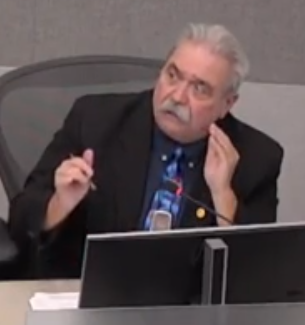 Councillor Angelo Bentivegna worked his connections and found some needed storage space for the Burlington Food Bank – Kudos to the Councillor. The long weekend gave the Food Bank a chance to get caught up – the now have about 45 food hampers ready to go out this morning.
For those who wonder what our City Councillors are able to do during the State of Emergency there was some news from Councillor Angelo Bentivegna who was able to locate and provide some storage space for us.
Good timing as Feed Ontario will be delivering some pre-made hampers to us expected sometime this week.
Food Bank Update today

 By Staff By Staff
April 15th, 2020
BURLINGTON, ON
Police Make Arrest in Steroid Trafficking Investigation in Burlington.
The Halton Regional Police Service has made an arrest in relation to a Steroid Trafficking investigation in Burlington which began in March, 2020.
 The evidence. Investigation by the Burlington Street Crime Unit on April 14th, 2020 has led to charges against the following individual;
Shane JOORIS (35 Years of Burlington)
- Trafficking in a Controlled Substance (Steroids) – 2 counts
- Possession for the Purpose of Trafficking a Controlled Substance (Steroids)
A search warrant was executed at a Burlington residence and the following items were seized:
- 31 various steroids and medications used for bodybuilding
$20,230 worth of drugs were seized as a result of the search warrant.
The accused was released on an Undertaking.
Tips can also be submitted anonymously to Crime Stoppers. “See something? Hear something? Know something? Contact Crime Stoppers” at 1-800-222-8477 (TIPS) or through the web at www.haltoncrimestoppers.ca.
Please be reminded that all persons charged are presumed innocent until proven guilty in a court of law.

 By Pepper Parr By Pepper Parr
April 14th, 2020
BURLINGTON, ON
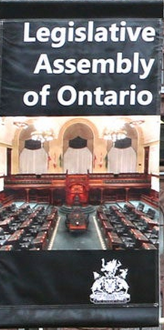 A breath of fresh air ? Included in the debate in the Legislature today was a decision “making it possible to suspend certain municipal planning decision timelines during the state of emergency, and change the Development Charges Act to ensure municipalities can continue to count on a vital source of revenue that helps pay for local growth-related infrastructure, such as roads, water and sewers as well as fire and police services.” A breath of fresh air ? Included in the debate in the Legislature today was a decision “making it possible to suspend certain municipal planning decision timelines during the state of emergency, and change the Development Charges Act to ensure municipalities can continue to count on a vital source of revenue that helps pay for local growth-related infrastructure, such as roads, water and sewers as well as fire and police services.”
The announcement was made in the Legislature – we now have to wait for the specifics that will be released by the Minister of Municipalities and Housing.
Many will wait to see what reference is made, if any, on the processes and procedures that apply to Local Planing Act Tribunal.

 By Pepper Parr By Pepper Parr
April 14th, 2020
BURLINGTON, ON
I didn’t know John Calvert. I knew of him. He was Director of Planning in Mississauga at a time when Hazel McCallion was Mayor – and he survived – Hazel was one tough cookie.
I was sent a copy of the letter Calvert wrote to Mayor Marianne Meed Ward expressing his profound disappointment on how the National Homes development on Brant was proceeding.
John Calvert has lived in Burlington for more than 30 years. Watching the shape, look, and feel of the city disintegrate has bothered him for some time.
 John Calvert: Deeply hurt and disappointed I had to ask a friend for contact information and see if Calvert would take a call from me.
He said he would and we had a ten minute talk.
I heard a very distraught man who was deeply hurt talk about the Due Process that he did not feel had taken place and the need for public input on planning decisions.
He agreed with me that people were excited when Marianne was elected Mayor – many believed that the development proposals on the table were going to ruin the city.
Calvert said he “likes Marianne” he just didn’t seem to like what she was doing.
“It took me some time to write the letter” said Calvert. “I showed it to my neighbour Ed Doer who was heavily involved in the opposition to the National Homes development; he said I had written what needed to be said.”
When Mayor Meed Ward went to France to take part in the 75th WWII anniversary she went with Calvert’s wife who was one of the Burlington residents who made the Juno Beach reception centre possible. Calvert told me that the two women travelled together and got along very well.
Calvert said he was asked to speak at one of Meed Ward’s campaign funding events. “I did so willingly” said Calvert
Calvert knows the ins and out of the planning profession. He told me that the communities we build today will determine the kind of society we will have a couple of decades later.
He talked about the lack of amenities in a community that was to have 233 homes – which may have been chiselled down to 215.
“The traffic problems will be horrendous.”
Calvert hopes that this Council decides to take a sober second look at what is being proposed.
The issue for Calvert is trust and quality in developments. By quality he doesn’t mean quartz counter tops and shiny high end stoves. He means space for people to live, back yards where there is room for one of those large Italian families and parks where children can play and enough room for a child to learn to ride a bicycle.
Calvert said he was excited when Meed Ward came along – mistakes that had been made were going to be corrected. Now it doesn’t look that way.
“Someone has to stop this” he said
Related news item:
The Calvert letter
Salt with Pepper is the musings, reflections and opinions of the publisher of the Burlington Gazette, an online newspaper that was formed in 2010 and is a member of the National Newsmedia Council.

 By Pepper Parr By Pepper Parr
April 14th, 2020
BURLINGTON, ON
 Premier Doug Ford – sweating out a very tough situation. During a media conference call hours ago, Ontario Premier Doug Ford said that Ontario Schools would not be re-opening on May 4th and that the Minster of Education will be making an announcement on that matter in a few days.
The Premier added that the decision to not open the schools on the 4th “does not mean that the school year is lost”.

|
|
 By Pepper Parr
By Pepper Parr



 Mayor Marianne Meed Ward cautions people. “As the weather gets warmer we know it will be harder to follow the provincial emergency orders, and the directives from Burlington City Hall. But we must continue to stay apart, and stay in our own neighbourhoods, so we can get through this sooner. Please resist the urge to congregate in groups, stay 6 ft. away from anyone you don’t live with and please stay in your own neighbourhood and local parks for your walks.
Mayor Marianne Meed Ward cautions people. “As the weather gets warmer we know it will be harder to follow the provincial emergency orders, and the directives from Burlington City Hall. But we must continue to stay apart, and stay in our own neighbourhoods, so we can get through this sooner. Please resist the urge to congregate in groups, stay 6 ft. away from anyone you don’t live with and please stay in your own neighbourhood and local parks for your walks.






















 But more important than the two is the street.
But more important than the two is the street.








 Quebec has called on the federal government to bring in the army’s medical corps to help with their lack of health care at long term facilities But Ontario is putting an ‘iron ring’ around its institutions according to its premier, who has promised to leave no stone unturned, spare no expense.…
Quebec has called on the federal government to bring in the army’s medical corps to help with their lack of health care at long term facilities But Ontario is putting an ‘iron ring’ around its institutions according to its premier, who has promised to leave no stone unturned, spare no expense.…









 By Jim Young
By Jim Young

 Jim Young is an Aldershot resident who delegates at city council on transit and local development. He is consistent in his mission to ensure local government is transparent and accountable to the people who elected them.
Jim Young is an Aldershot resident who delegates at city council on transit and local development. He is consistent in his mission to ensure local government is transparent and accountable to the people who elected them.



 The Hospital Foundation is inviting people to show their support for the hospital and staff by displaying a We Love Our Hospital lawn sign.
The Hospital Foundation is inviting people to show their support for the hospital and staff by displaying a We Love Our Hospital lawn sign.





 A breath of fresh air ? Included in the debate in the Legislature today was a decision “making it possible to suspend certain municipal planning decision timelines during the state of emergency, and change the Development Charges Act to ensure municipalities can continue to count on a vital source of revenue that helps pay for local growth-related infrastructure, such as roads, water and sewers as well as fire and police services.”
A breath of fresh air ? Included in the debate in the Legislature today was a decision “making it possible to suspend certain municipal planning decision timelines during the state of emergency, and change the Development Charges Act to ensure municipalities can continue to count on a vital source of revenue that helps pay for local growth-related infrastructure, such as roads, water and sewers as well as fire and police services.”







